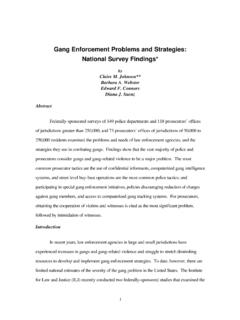Transcription of (The Good), The Bad and The Ugly: The Visual Construction ...
1 Journalism and Mass Communication, September 2015, Vol. 5, No. 9, 480-494. doi: D DAVID PUBLISHING. (The Good), The Bad and the ugly : The Visual Construction of Female Child Sex-offenders Charlotte Barlow, Adam Lynes Birmingham City University, Birmingham, England This paper explores the Visual Construction and representation of female sex offenders. It utilises the case study of Vanessa George, a nursery worker who was involved in the exchange of indecent imagery of children via an online paedophile ring. The first part of the paper considers the emergence of the sub-discipline, Visual criminology and examines what is known about the Visual representation of female offenders.
2 The second part presents the findings of an empirical investigation, which involved engaging in a critical, reflexive Visual analysis of a selection photographs and the police mugshot of Vanessa George. The paper considers the ways in which George s physical appearance and her suggested ability to deceive were used to visually represent her as other , thus reinforcing the existing simplistic motifs of female sex offending. Keywords: female child sex offenders, Visual representation Introduction . In recent years within criminology there has been a growing recognition of the significance and spectacle . of the image, emphasising the cultural, social, and political power of images of crime and criminal justice issues (For example, Rafter, 2014; Ferrell, Hayward, & Young, 2008; Hayward & Presdee, 2010; Carrabine, 2014).
3 Photography in particular has captured the attention of criminologists since the work of Lombroso and Ferrero (1893), emphasising the denotative and connotative power of this form of imagery (Sekula, 1981, 1984;. Barthes, 1977). Despite Lombroso and Ferrero s (1893) work being published during the Victorian period, it provides a useful insight into the myths and prejudices that remain to have a significant impact on the study of women and crime today, particularly in terms of dominant images of female offending (Lloyd, 1995). In spite of this increasing recognition of the Visual within criminology, there has been little research which explicitly explores the Visual representation of women criminals.
4 Much of the existing literature locates this analysis within a media representation context and considers the use of imagery in relation to image placement and page layout (Birch, 1993; Jones & Wardle, 2008). Furthermore, particularly significant to this paper is that the Visual Construction of female sex offenders is distinctly absent from this discussion. Conversely, this paper applies a critical and reflexive approach to the Visual Construction of Vanessa George thus challenging the bogus of positivism associated with criminology (Young, 2011; Pink, 2007). It considers how photographs and mugshots may represent the cultural and social processes that underpin the Construction and public understanding of female sex offenders.
5 This paper not only seeks to deconstruct the images of George, but to Charlotte Barlow, , Lecturer in Criminology, School of Social Sciences, Birmingham City University. Adam Lynes, , Lecturer in Criminology, School of Social Sciences, Birmingham City University. (THE GOOD), THE BAD AND the ugly 481. also use the images as an introduction to a discussion about the over-simplistic, partial and androcentric Construction of female sex offenders more broadly. Visual Criminology and the Image Criminology, despite its multi and cross- disciplinary nature, has struggled to build and maintain a strong Visual focus. Despite this, Ferrell et al.
6 (2008) stresses that it is difficult to conceive how the discipline of criminology could not be considered as Visual , as we live in an era where images of crime and deviance are frequently thrust into the public eye and consciousness through a rich variety of media sources from true crime books, television shows, film and news outlets. In recent years, the significance of the image in relation to crime and deviancy has been increasingly recognised, particularly within the sub-discipline of cultural criminology. Whilst, as Ferrell (1999) highlights, cultural criminology has a vested interest in the analysis of Visual data in relation to media representation of crime, such analysis and attention to the Visual tends to be over-lapped with and, at times, neglected in favour of written narrative (Rafter, 2014).
7 As such, there has been a void within the wider framework of criminology, and an apparent reluctance to focus explicitly on the Visual representation of crime. Rafter (2014, p. 27) argues that conventional criminology would have difficulty explaining the meanings of images . This is, according to Rafter, a reoccurring issue within the field of criminology. With countless numbers of Visual representations of crime, a potentially large data set is being neglected which may provide a rich source for the further development of the discipline. However, due to this increasing recognition of the significance of the Visual , there has been a recent emergence of the sub-discipline Visual criminology.
8 According to Rafter (2014, p. 129), Visual criminology is the study of the ways in which all things Visual interact with crime and criminal justice, inventing and shaping one another . Visual criminology engages with the meaning, affect, symbolic power and spectacle of the image , thus encouraging a critical engagement with and expansion of the criminological imagination (Hayward & Presdee, 2010; Young, 2011). To fully engage with a Visual criminological approach, Visual analysis must be attuned to representation as well as the ways in which Visual culture impacts upon individual and collective behaviour (Hayward, 2010).
9 Photography and the birth of the camera intersects with criminology in many ways, such as the traditional police photograph or mug shot (Carrabine, 2014) or less obvious examples, such as the fingerprint (Finn, 2009). The power of photographs lies in their ability to work denotatively, appearing to display real life events, as well as connotatively, visually representing larger hidden codes of meaning (Sekula, 1981, 1984; Barthes, 1977). Photographs are often understood as being a more objective form of representation, hence why they are often used in law enforcement and criminal identification (Finn, 2009; Marder, 2013).
10 However, irrespective of the ability of the photograph to capture a moment in time and the consequential belief that this leads to an objective truth , the subjective influence of the photographer on the end result has increasingly been recognised (Finn, 2009). Sekula (1981) challenged approaches to photography that ignored the social and political functions of images and exposed their ideological interplay in wider systems of classification, control and order. Furthermore, Ferrell and van de Voorde (2010, p. 41) argue that a photograph captures not that of the people in front of the lens, nor that of the photographer, but of the shared cultural meaning created between the photographer and those photographed in a particular context.




